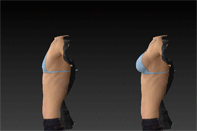One of the most common questions among women seeking information on breast augmentation is whether or not their implants can freeze in the cold weather.
Since breast implants are filled with liquid or gel, and since liquids have a freezing point, it’s actually a smart question to ask.
The short answer to this question is, no, your breast implants are not going to freeze in the cold weather. If it were a possibility that the materials and liquids used within modern breast implants could freeze at normal outside temperatures, then they wouldn’t be used at all.
When it comes to medical implants, they are put through rigorous testing to ensure that they can withstand the extremes that the human body would experience on a daily basis. Sure, there are rare circumstances that can lead to something unfortunate happening, but for the majority of the population, you will never experience these extremes that could cause a breast implant to fail.
Saline Breast Implants vs. Silicone Breast Implants and Cold Weather
Breast implants on the market today are filled with either a saline solution or a silicone gel. The silicone gel is filled with a semi-solid silicone gel, which allows the implant to be soft and pliable for breasts that look and feel natural. Saline breast implants are filled with a sterile salt-water solution.
The fact that saline is made up of a saltwater solution has led to the myth that it may be possible for breast implants to freeze, because water itself can freeze if it’s too cold, but because these implants are not made of just water, this is not possible.
So, what actually happens to breast implants when the temperatures outside get into the freezing levels?
Will My Saline Breast Implants Freeze in the Cold?
Regardless of the type of breast implant you choose to use, whether silicone based or saline based, you will never have to worry about your breast implants freezing within your chest. It is physically impossible.
The myth of the freezing breast implant seems to stem from the fact that saline based implants are comprised mainly of water and since water has a freezing point, then this could possibly lead to your breast implants freezing within your body if the temperature dips below 28.4 degrees Fahrenheit (the freezing point of salt water).
But you don’t have to worry – once they’re implanted in the body, breast implants will not freeze, no matter how cold it gets!
Breast implants cannot freeze because the core temperature of the human body hovers right around 98.6 degrees Fahrenheit, regardless of indoor or outdoor temperatures. When placed within the body, breast implants are insulated under the pectoral muscles, and the skin, and your natural internal body temperature regulates the temperature of the implants.
What is the Freezing Point of Saline and Silicone Gel?
For saline implants to freeze inside the body, the internal body temperature would have to drop to below 28.4 degrees, which is well below the temperature necessary to sustain life. And silicone gel implants would have to drop to 170 degrees below zero.
The lowest ever-recorded survived body temperature of human being was 56.7 degrees Fahrenheit, well above the freezing point of salt water. There is no physical way your body can survive at these low temperatures, which means there is no way that your breast implants can possibly freeze if you are alive.
In 20 years of practice, Dr. Adams has never seen a patient with any issue or complaint from cold weather and breast implants. He states, the “implant freeze stories are urban legends…”
Regardless of the type of filler, implants can experience slight variation in temperature based on the ambient temperature outside and how long a person was exposed. Most of the time this goes un-noticed by the patient and will absolutely not lead to freezing, or even partial freezing, of the breast implant.
Tips for Staying Comfortable in the Cold Weather
To keep warm when spending time outdoors in the cold, be sure to bundle up! Wearing a camisole or lightweight undershirt as a base layer underneath normal clothing is a smart idea for anyone who’ll be out in the cold for long period of time. A vest can help keep the core body temperature warm underneath a jacket or coat without adding too much extra heat to the rest of the body.
Keeping the extra layers on once back inside, taking a hot shower, or spending a few minutes in a hot tub or sauna can help the breasts warm up more quickly to match the rest of the body’s temperature, just as you would do if your hands were cold after coming inside.
Your Breast Implants Will Not Freeze in Cold Weather
The myth of breast implants freezing is just that, a myth. If you live in an area of the world that sees temperature drops below freezing, your body will naturally regulate the temperature of the implants the same way it does with the other organs within your body.
If your body ever reached the low temperatures required for saline or silicone gel breast implants to freeze, your breast implants would be the least of your worries.
You can schedule a consultation with Dr. Adams, or contact us with any questions.
















